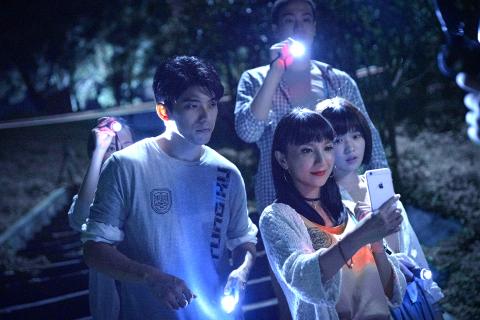The team behind The Tag-along (紅衣小女孩) and The Rope Curse (粽邪) tackle another real-life haunted legend in The Bridge Curse (女鬼橋), with promises of groundbreaking storytelling that will give a new spin to a popular but run-of-the-mill ghost tale.
The film is based on the legend of the haunted bridge at Taichung’s Tunghai University (東海大學), which has been changed to Donghu University (東湖大學) here. It’s one of those standard tales involving a female student who is supposed to meet her lover at the bridge to elope. The lover never shows, and she drowns herself in the lake. The student has haunted the bridge ever since, and it’s said that at midnight, an extra 14th step will appear on the stairs following the bridge, and whoever turns around before reaching the top will disappear.
In 2018, a Tunghai student was livestreaming at the bridge at night when viewers spotted what looked like a female ghost in white behind him and urged him to run for his life, forming the basis for the plot. The opening scene depicts a group of students preparing to livestream themselves walking up the stairs at midnight as a promotion video for a “test of courage” activity for incoming freshmen, and things go awry from the very beginning.

Photo courtesy of atmovies.com
Is the use of annoyingly shaky cell phone footage with live comments what the filmmakers refer to as revolutionary? Thankfully it isn’t, but the problem is that the film just takes way too long to start breaking from the mold to get to the final twist. The first three-quarters of the film follow a typical haunted school formula, with not very frightening jump scares and a generic female ghost that borders on the comical.
The production is (aside from the ghost) refined, making use of atmospheric shifts as well as lighting to set the mood instead of overly relying on special effects, which The Tag-along was criticized for. The acting by the up-and-coming thespians (especially Chang Ning, 張甯, and Vera Yen, 嚴正嵐) is also decent across the board. There are some subplots such as a love triangle and a female journalist investigating supernatural events, but one’s patience starts wearing thin as the film drags on.
Then things suddenly get interesting in the last 20 minutes, but everything happens so quickly with all the tantalizing, mind-bending bits jammed into the final sequences that it’s hard to keep up with the sudden downpour of revelations. No wonder many people watched the movie twice to fully understand it.
Director Lester Shih’s (奚岳隆) ability is evident in his feature debut as he skillfully utilizes various devices to conceal the secret to the very end, while dropping many subtle hints that will make sense much later — but unfortunately at the expense of the first half. This last part should have been drawn out a lot more, perhaps with the journalist playing a larger role, making the film more of a trippy, horror-tinged mystery thriller instead.
The Bridge Curse is part of what seems to be a movement in the past five years or so to make the public aware of supernatural Taiwanese folk tales, and given its box office success (NT$23 million over the 228 Peace Memorial Day long weekend), the interest is definitely there. The film has the right elements, ideas and technical capabilities, and its final twist definitely will get people talking — it just needs better structuring and could be much scarier.

April 14 to April 20 In March 1947, Sising Katadrepan urged the government to drop the “high mountain people” (高山族) designation for Indigenous Taiwanese and refer to them as “Taiwan people” (台灣族). He considered the term derogatory, arguing that it made them sound like animals. The Taiwan Provincial Government agreed to stop using the term, stating that Indigenous Taiwanese suffered all sorts of discrimination and oppression under the Japanese and were forced to live in the mountains as outsiders to society. Now, under the new regime, they would be seen as equals, thus they should be henceforth

Last week, the the National Immigration Agency (NIA) told the legislature that more than 10,000 naturalized Taiwanese citizens from the People’s Republic of China (PRC) risked having their citizenship revoked if they failed to provide proof that they had renounced their Chinese household registration within the next three months. Renunciation is required under the Act Governing Relations Between the People of the Taiwan Area and the Mainland Area (臺灣地區與大陸地區人民關係條例), as amended in 2004, though it was only a legal requirement after 2000. Prior to that, it had been only an administrative requirement since the Nationality Act (國籍法) was established in

With over 80 works on display, this is Louise Bourgeois’ first solo show in Taiwan. Visitors are invited to traverse her world of love and hate, vengeance and acceptance, trauma and reconciliation. Dominating the entrance, the nine-foot-tall Crouching Spider (2003) greets visitors. The creature looms behind the glass facade, symbolic protector and gatekeeper to the intimate journey ahead. Bourgeois, best known for her giant spider sculptures, is one of the most influential artist of the twentieth century. Blending vulnerability and defiance through themes of sexuality, trauma and identity, her work reshaped the landscape of contemporary art with fearless honesty. “People are influenced by

Three big changes have transformed the landscape of Taiwan’s local patronage factions: Increasing Democratic Progressive Party (DPP) involvement, rising new factions and the Chinese Nationalist Party’s (KMT) significantly weakened control. GREEN FACTIONS It is said that “south of the Zhuoshui River (濁水溪), there is no blue-green divide,” meaning that from Yunlin County south there is no difference between KMT and DPP politicians. This is not always true, but there is more than a grain of truth to it. Traditionally, DPP factions are viewed as national entities, with their primary function to secure plum positions in the party and government. This is not unusual